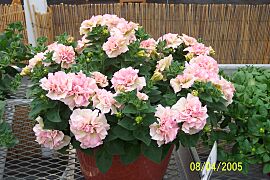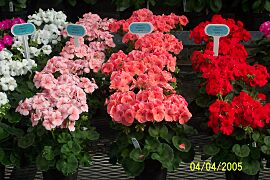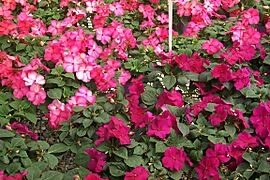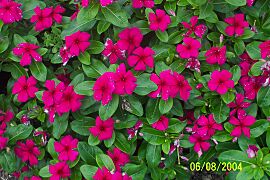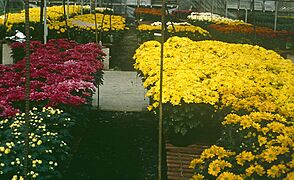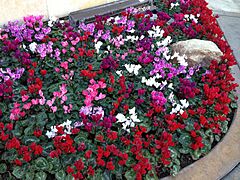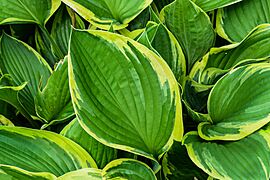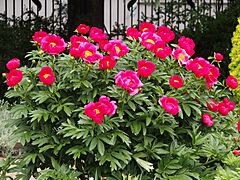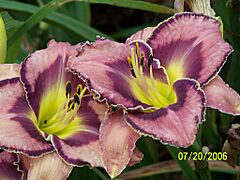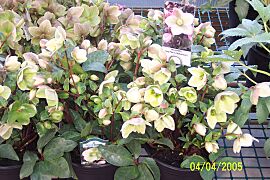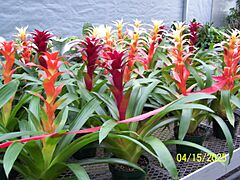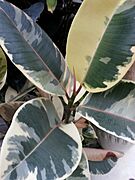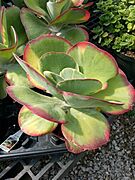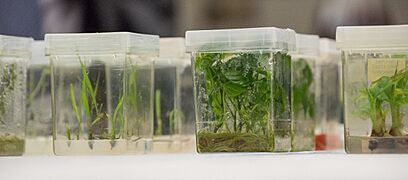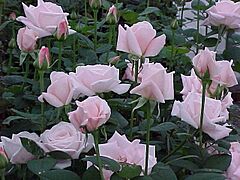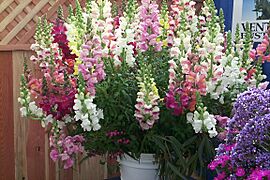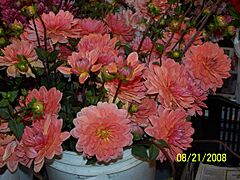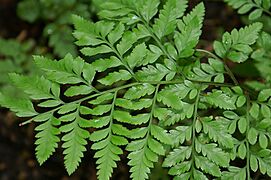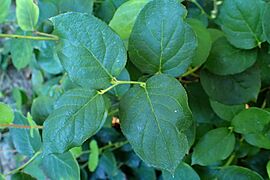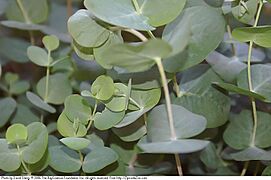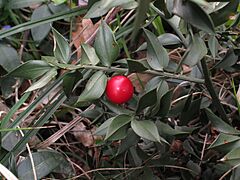Floriculture facts for kids
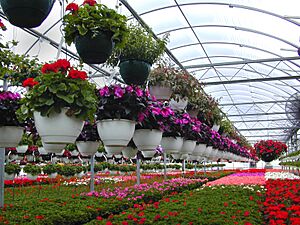
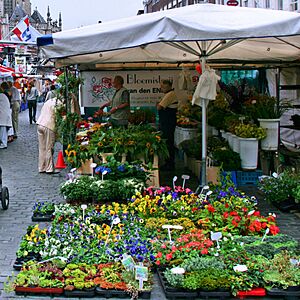
Floriculture is a special part of horticulture and agriculture. It's all about growing plants that have beautiful, colorful flowers or interesting leaves. These plants are grown for people to enjoy and to make our surroundings look nicer.
This field is a big business all over the world. Over the years, experts have found the best ways to grow many different kinds of plants used in the floral industry. This has helped us learn a lot about how plants grow. Also, by breeding and choosing plants carefully, people have created thousands of new types of flowers. Some popular flowers grown for business include Jasmine, marigold, chrysanthemum, rose, orchid, and anthurium.
Contents
What is Floriculture?
Flowers are an important part of human life. We use them for happy times and sad times, and they are part of our everyday world. Flowers and plants can be found indoors by a sunny window, in gardens, or on patios. People have been studying flowers and plants for a long time. They want to understand how plants interact with humans. Floriculture scientists around the world work to figure out how to grow these plants so everyone can enjoy them.
Floriculture crops include many types of plants. These are cut flowers (flowers picked to be used in bouquets) and cut cultivated greens (leaves and branches used with flowers). It also includes bedding plants (garden flowers, also called annuals and perennials). And of course, there are houseplants, which can be foliage plants (grown for their leaves) or flowering potted plants (grown for their flowers).
These plants are grown in different ways. Some are grown in fields, while others are grown in containers inside a greenhouse. Often, special protected places like greenhouses are used. This is because these plants are very valuable to people.
Growing flower crops can be simple or very advanced. Some crops grow in soil in farm fields or in simple high tunnel greenhouses. For many years, flowers were grown close to where they were sold. This was usually in Europe, North America, and Asia. However, many flowers for the floral industry are now grown in specific climates. Often, this is in the mountains of South America, Africa, or China. This allows certain plants to grow all year round, and there are people available to help grow them.
Specialized greenhouses have developed as flower crops and markets have changed. Floriculture is a big part of controlled-environment agriculture (CEA). Because floriculture crops are so valuable, expensive growing systems are often used. These include greenhouses, automatic climate control, and automated irrigation (watering) and fertilization (feeding). Some places even use robots to handle seeds, young plants, and containers. Extra lights are also used to help plants grow. All this helps grow these plants efficiently for markets worldwide. Some plants are watered by hand. But most are watered using drip irrigation, boom irrigation, or flood floors. Hydroponics (growing plants without soil) can also be used for many cut flower crops.
Floriculture's Global Value
The floriculture market around the world was worth about US$50 billion in 2022. It is expected to grow to over US$58 billion by 2028. This shows how important and valuable flowers are globally.
Types of Floriculture Plants
Annual Bedding and Garden Plants
These are plants that complete their life cycle in one growing season. They are often planted in gardens for colorful displays.
-
Vinca - Catharanthus roseus
Potted Flowering Plants
These are plants grown in pots, usually for indoor decoration, that produce beautiful flowers.
-
Poinsettia 'Premium Red' - Euphorbia pulcherrima
-
Cyclamen - Cyclamen persicum
Herbaceous Perennial Plants
These plants live for more than two years. Their stems usually die back in winter, but the roots survive to grow again in spring.
-
Daylily - Hemerocallis fulva
-
Lenten rose - Helleborus
Foliage Plants for Indoor and Patio Use
These are houseplants grown mainly for their attractive leaves rather than their flowers.
Young Plants for Floriculture
These are the starting materials used to grow new floriculture crops.
Cut Flowers
These flowers are grown to be cut from the plant and used in bouquets, arrangements, and decorations.
-
Sunflower - Helianthus annuus
Cut Cultivated Greens
These are leaves, stems, or branches grown to be cut and used with cut flowers in arrangements.
-
Leatherleaf fern - Rumohra adiantiformis
-
Salal - Gaultheria shallon
-
Silver dollar - Eucalyptus cinerea
How Floriculture Has Improved
Over many years, people who love and grow plants have learned a lot about how to grow certain types. For example, Chrysanthemums have been grown in China for over 3000 years! This means growers knew a lot about them. Floriculture scientists have continued this learning. They now control the plant's environment to make flowers bloom exactly when people want them for celebrations.
Photoperiodism: How Light Affects Flowering
Chrysanthemums were key in experiments that helped us understand photoperiodism. This is how plants react to the length of day and night. Even though ancient growers likely knew this from experience, scientists studied it deeply. They found that temperature also affects how plants respond to light. Many cut flowers and bedding plants grow faster if they get the right amount of light each day. Growers use special lights to make the day longer or black cloths to make it shorter. This helps them grow plants more efficiently.
Plant Tissue Culture: Growing Many Plants from Tiny Pieces
Growing new plants has always been part of gardening. Plant tissue culture started as a way to save tiny orchid embryos. This helped orchid lovers create new types of orchids. From the 1950s to the 1980s, many scientists worked on growing plants using tissue culture. This helped them learn how to grow many different kinds of plants this way.
Tissue culture allows growers to make many copies of new and unique plants very quickly. Many types of foliage plants are only available because of tissue culture. For example, geraniums grown this way were treated with heat. This helped find and remove many viruses from them. This process is called "virus-indexed." Sometimes, when viruses were removed, some of the plant's natural traits changed. This led plant breeders to keep some viruses in future plant types. Heat treatment of tissue cultures is now used for many plants to remove harmful bacteria and viruses.
Containers and Growing Mixes
People have used different kinds of pots to grow plants for a long time. Often, they would put garden soil in a pot, add a plant, and water it regularly. This was simple but needed careful watching to avoid overwatering.
This worked well with deeper pots, usually 6-10 inches (15–25 cm) deep. Gravity would pull water down, so the soil had enough air for the roots. In the 1950s and 1960s, greenhouses in the U.S. started growing more bedding plants. They needed smaller containers for easier spacing and shipping. But it was easy to overwater plants in these smaller pots if they used regular garden soil.
So, the first step was to add peat moss and perlite to the garden soil. Later, they used other materials like sphagnum moss peat and vermiculite. This mix was called the Cornell peat-lite mix. In the 1970s, more materials were used for growing media by companies that made and sold these mixes. Scientists had to study the properties of all these materials.
When growing young plants (plugs) became more common in the 1980s, and machines started planting seeds and young plants, more research was needed. This was important for managing the small amount of growing mix in plug trays. Research continues today on all parts of growing mixes and pot designs.
However, using peat for growing mixes is an environmental concern. So, growers are looking for more sustainable materials. These include pine bark, coco coir (from coconuts), and wood fiber. Finding eco-friendly growing materials is a top goal for the industry.
Reducing Pesticides
Pesticide residues (small amounts of chemicals left behind) are still an issue for floriculture plants. Some countries have few rules on pesticide use. But flower handlers and customers could be exposed to these residues.
Also, some pesticides, like neonics, are a big worry because they harm bees and other pollinators. If these pesticides are used on garden flowers grown in greenhouses, they can greatly affect pollinator populations in people's gardens.
Scientists are now researching biological control. This means using natural enemies or methods to control insects, mites, and plant diseases in greenhouses. The goal is to reduce the need for chemical pesticides in floriculture.
Extra Lighting for Plants
Adding extra light for flower crops started with understanding photoperiodism. People wondered if artificial lights could replace sunlight in winter. Old incandescent lamps didn't work well. So, floriculture had to wait for better lighting technology.
Newer fluorescent lamps and industrial lamps (like high-pressure sodium lights) helped improve plant growth for geraniums, roses, and other crops. In the following years, using artificial lighting became common in Europe, North America, and Japan.
Scientists also worked to figure out how much light plants need from both natural and artificial sources. They came up with the term daily light integral (DLI). This measures the perfect amount of light energy each plant needs to grow its best.
The invention of LED (light-emitting diode) lamps offered even more chances for extra lighting. These lamps use less energy, stay cooler, and allow growers to change the color of light. Different colors of light can help plants grow in specific ways.
Extra lighting is now used to help seedlings, bedding plants, cut flowers, and other crops grow as well as possible.
Plant Food, Water Quality, and Watering
In the past, flower crops were grown in regular field soil, just like other farm crops. The important nutrients for flowers were in the soil. Growers would add organic matter and animal manure to help. But these natural additions were a lot of work and not always consistent. This made it hard to grow the best flowers.
In the 1950s and 1960s, floriculture started using special growing media (like the peat mixes) and inorganic fertilizers (man-made plant food). This happened as growing plants in containers became more important. This change was supported by research into hydroponics, which is growing plants without soil. The "soil-less" nature of hydroponics was similar to the "soil-less" nature of the new growing media.
See also
- Floriculture in Canada
- Floriculture in Taiwan


